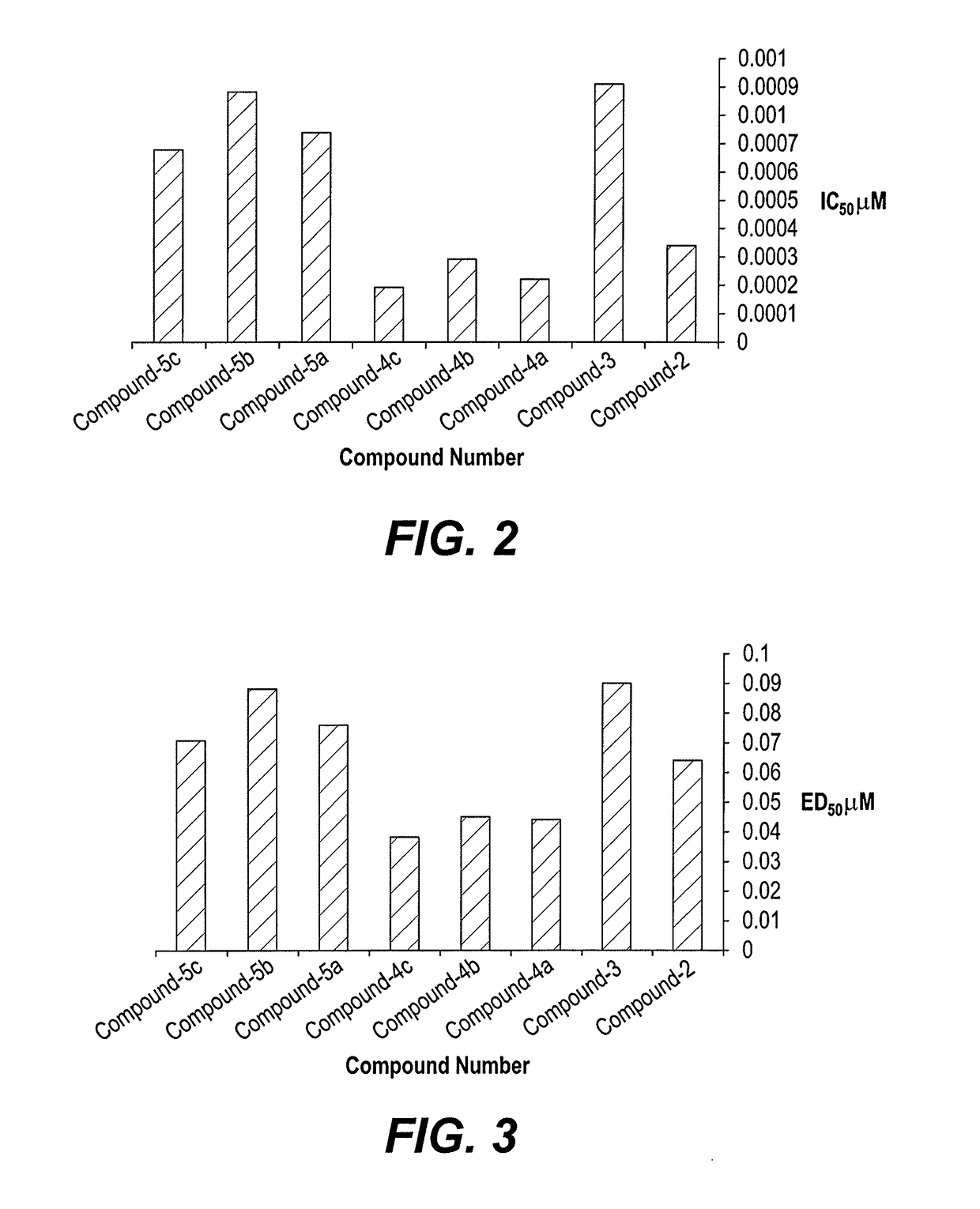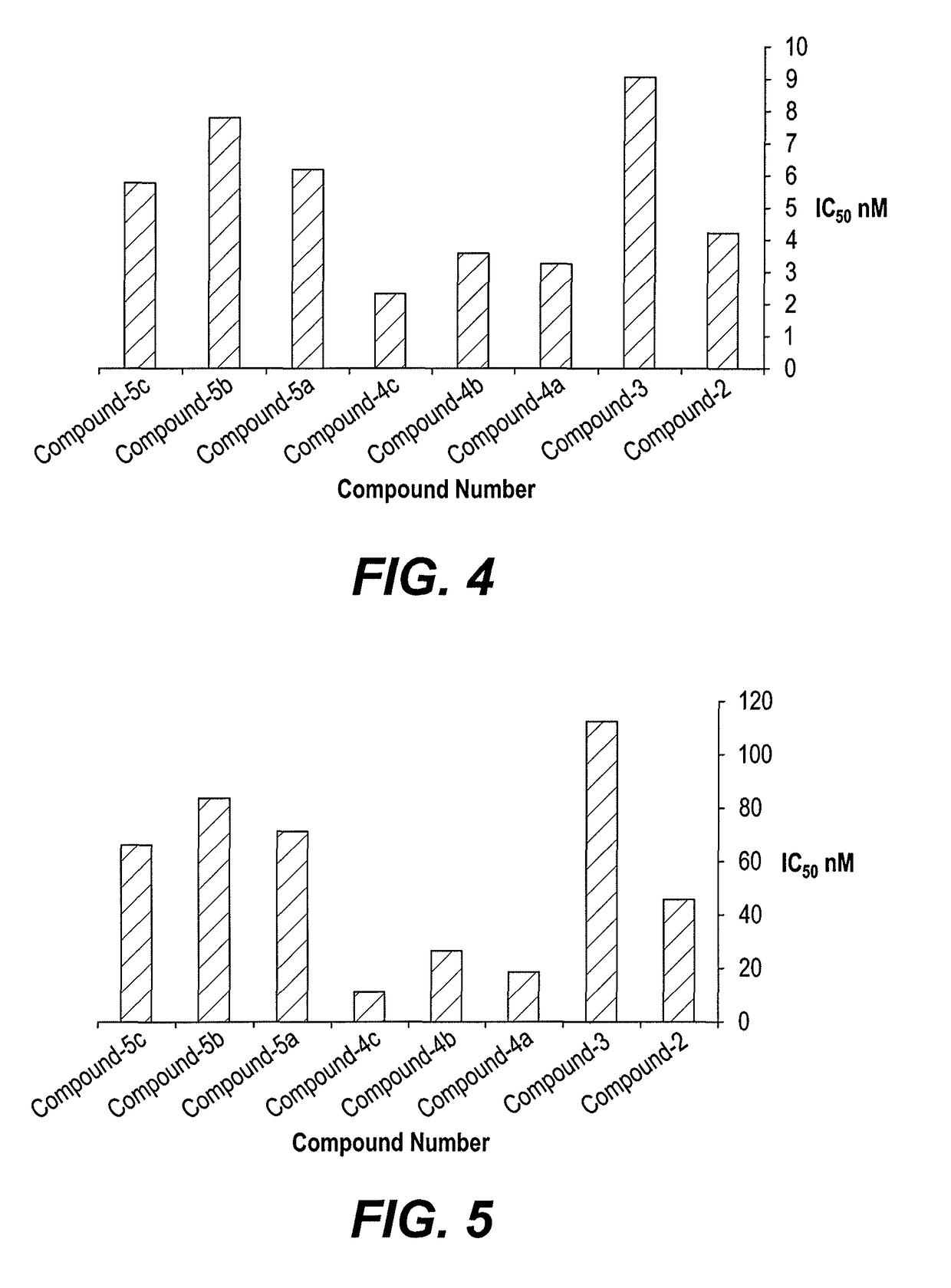Abietic acid derivatives as anti-tumor agents
a technology of abietic acid and derivatives, applied in the field of anti-tumor agents, can solve the problems of prostate cancer, often undiagnosed, and often accompanied by harsh side effects
- Summary
- Abstract
- Description
- Claims
- Application Information
AI Technical Summary
Benefits of technology
Problems solved by technology
Method used
Image
Examples
example 1
Synthesis of Intermediate Compounds 2 and 3
[0026]As reflected in FIG. 1, a mixture of abietic acid 1 (3.02 gm, 10 mmol) and ethyl chloroformate (1.25 ml, 10 mmol) in 125 ml. of a 1:1 mixture of tetrahydrofuran and dimethylsulfoxide was stirred for one hour in the presence of trimethylamine (0.75 ml, 10 mmol), at room temperature. Sodium azide (0.65 gm, 10 mmol) was added to the reaction mixture, which was then stirred for one hour at room temperature. The reaction mixture was then poured into water, and the resulting precipitate was filtered off, dried and washed with benzene to remove un-reacted starting material. The resulting product mixture was fractionated using a medium pressure chromatography system on a silica gel column using benzene / ethyl acetate (9:1) as solvent, at a pressure of 12 bar and a flow rate of 4 ml / min−1, to separate the two lactone compounds 2 and 3.
example 2
Analysis of Compound 2 (Abieta-7, 13-dien-18-oic acid (18→2) lactone (2))
[0027]Yield 42%, mp. 227-229° C., [α]D25=+112 (c 1, MeOH). IR (KBr, cm−1): 2988 (CH, aliphatic), 1747 (C═O), 1637, (C═C). 1H NMR (DMSO-d6): 0.87 (s, 3H, CH3, C-20), 1.21 (s, 6H, 2CH3, C-16&17), 1.28 (s, 3H, CH3, C-19), 1.36 (t, 2H, CH2, 1H), 1.44 (t, 2H, CH2, 3H), 1.63 (t, 2H, CH2, 11H), 1.76 (m, 1H, CH, 15H), 1.92 (d, CH2, 2H, H), 1.96 (t, CH2, 2H, 12H), 2.0 (t, 1H, CH, 9H), 2.52 (t, 1H, CH, 5H), 4.28 (m, eq-1H, CH, 2H), 5.36 (m, 1H, 7H), 5.77 (s, 1H, 14H). 13C NMR (DMSO-d6): δ ppm 38.32 (C-1), 65.55 (C-2), 37.23 (C-3), 46.35 (C-4), 44.97 (C-5), 25.67 (C-6), 120.55 (C-7), 135.54 (C-8), 51.00 (C-9), 34.5 (C-10), 22.59 (C-11), 27.56 (C-12), 145.17 (C-13), 122.58 (C-14), 34.89 (C-15), 20.90 (C-16), 21.48 (C-17), 183.77 (C-18), 16.73 (C-19), 14.0 (C-20). MS (EI): m / z 300 (100%) [M+]. Anal. Calculated for C20H28O2 (300.43): Calculated C, 79.96; H, 9.39. Found C, 79.90; H, 9.35.
example 3
Analysis of Compound 3 (Abieta-7,13-dien-18-oic acid (18→6) lactone (3))
[0028]Yield 41%, mp. 301-303° C., [α]D25=+88 (c 1, MeOH). IR (KBr, cm−1): 2981 (CH, aliphatic), 1751 (C═O), 1648, (C═C). 1H NMR (DMSO-d6): 0.89 (s, 3H, CH3, C-20), 1.23 (s, 6H, 2CH3, C-16&17), 1.26 (m, 2H, CH2, 2H), 1.30 (s, 3H, CH3, C-19), 1.39 (t, 2H, CH2, 1H), 1.48 (t, 2H, CH2, 3H), 1.67 (t, 2H, CH2, 11H), 1.79 (m, 1H, CH, 15H), 1.98 (t, CH2, 2H, 12H), 2.04 (t, 1H, CH, 9H), 2.54 (t, 1H, CH, 5H), 4.31 (m, eq-1H, CH, 6H), 5.40 (m, 1H, 7H), 5.83 (s, 1H, 14H). 13C NMR (DMSO-d6): δ ppm 38.53 (C-1), 18.31 (C-2), 37.42 (C-3), 46.53 (C-4), 45.19 (C-5), 55.6 (C-6), 121.25 (C-7), 135.65 (C-8), 51.30 (C-9), 34.65 (C-10), 22.75 (C-11), 27.88 (C-12), 145.34 (C-13), 122.55 (C-14), 34.98 (C-15), 21.11 (C-16), 21.77 (C-17), 184.00 (C-18), 17.00 (C-19), 15.11 (C-20). MS (EI): m / z 300 (80%) [M+]. Anal. Calculated for C20H28O2 (300.43): Calculated C, 79.96; H, 9.39. Found C, 79.86; H, 9.28.
PUM
| Property | Measurement | Unit |
|---|---|---|
| Molar density | aaaaa | aaaaa |
| Molar density | aaaaa | aaaaa |
| Molar density | aaaaa | aaaaa |
Abstract
Description
Claims
Application Information
 Login to View More
Login to View More - R&D
- Intellectual Property
- Life Sciences
- Materials
- Tech Scout
- Unparalleled Data Quality
- Higher Quality Content
- 60% Fewer Hallucinations
Browse by: Latest US Patents, China's latest patents, Technical Efficacy Thesaurus, Application Domain, Technology Topic, Popular Technical Reports.
© 2025 PatSnap. All rights reserved.Legal|Privacy policy|Modern Slavery Act Transparency Statement|Sitemap|About US| Contact US: help@patsnap.com



